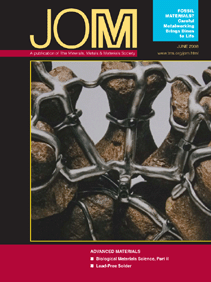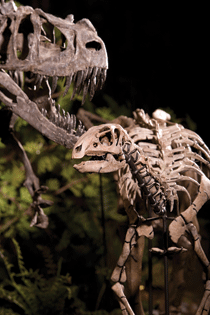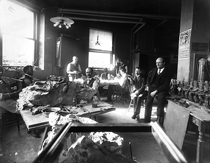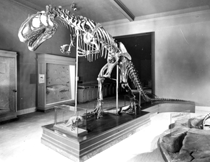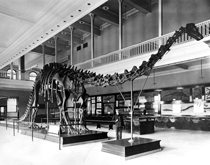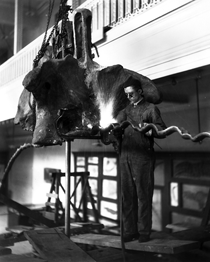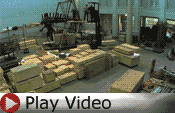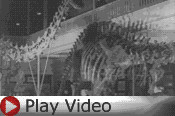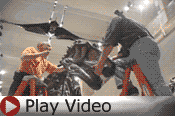|
INTRODUCTION
For 60 years, a Tyrannosaurus rex
stood tall in the Carnegie Museum
of Natural History, its ancient bones
posed awkwardly erect, more like a
sharp-toothed kangaroo than a tyrant
lizard king.
The display made sense to paleontologists
when it was erected. But science
has changed and so, in response,
has the Carnegie. The Pittsburgh,
Pennsylvania museum this month will
complete a massive renovation of its
dinosaur exhibit—the third-largest in
the United States. Over the last three
years, skeletons large and small have
been disassembled, cleaned, and rearticulated
into poses that reflect current
theory. And to pique the imaginations
of young dinosaur lovers, the skeletons
are arranged to suggest predator-versus-prey storylines.
To be sure, the stars of the $36 million
restoration are the Carnegie’s renowned
collection of fossils. But the
supporting players, unnoticed and yet
essential to the drama on the museum
floor, are the steel armatures that encase
them.
|
With the opening of the completed
Dinosaurs in Their Time exhibit, this
month, the once-towering T. rex will
be seen crouching low, neck practically
parallel to the ground, ready for
a Cretaceous period showdown with
another T. rex (Figure 1). Over in the
Jurassic section, which opened with
the exhibit’s first phase in November,
the stately Apatosaurus cranes its long
neck gracefully backward, (Figure 2)
facing a predator that seems to be closing
in (Figure 3).
To be sure, the stars of the $36 million
restoration are the Carnegie’s renowned
collection of fossils. But the
supporting players, unnoticed and yet
essential to the drama on the museum
floor, are the steel armatures that encase
them. The handcrafted frameworks allow
the T. rex to crouch low, ready to
fight. They raise the Diplodocus tail off
the ground and support its unwieldy
neck. And yet, the general public is unlikely
to appreciate this one-of-a-kind
hardware. That, says Matt Lamanna,
the museum’s assistant curator of vertebrate
paleontology, is the sign of expert
dinosaur mounting. “There is such attention to detail that a lot of people
don’t even see the armatures. That’s the
beauty of it,” he said.
DECONSTRUCTING DINOSAURS
Before he ever accepted the job
overhauling the Carnegie’s fossils, Phil
Fraley, founder of Phil Fraley Productions,
was well aware of the museum’s
legendary dinosaur hall. “Their collection
is actually the best collection in
the world of Sauropod dinosaurs,” he
said. “For me it was a dream come true
to be able to work with the Carnegie
Museum on this collection.” This from
a man who’d worked on such high-profile projects as the dinosaur hall restoration
at the American Museum of
Natural History in New York City and
the installation of Tyrannosaurus Sue at the Field Museum in Chicago.
The Pittsburgh exhibit would be his
company’s largest yet. The Carnegie
update would more than triple the size
of the museum’s dinosaur hall, grouping
the fossils according to the period
in which they lived, surrounding them
with an approximation of the plant life
of that time, and posing the bones to
reflect new thoughts on dinosaur biomechanics.
This would be the largest
renovation since the museum opened in 1895, and Fraley was eager
to be a part of it.
Of course, the primary goal was to
make the skeletons more scientifically
accurate. “Science is sort of a successive
approximation of the truth,” Lamanna
said. The truth as it was known
when the T. rex’s upright posture was
determined is different than the truth of
today. Another goal, though, was to imply
action with enough color and drama
to enthrall modern-day museum goers.
That was where the art of metalworking
was essential. When molded expertly,
the steel framework brings an
organic quality to the fossils, Fraley
said. “Really, what an armature is doing
is replacing all the tendons and ligaments—the soft tissue that used to
hold the animal together,” he said.
The ten skeletons Fraley’s team
would work on had their own armatures
already, and some had been standing for 100 years. That made the first
step in the project—dismantling the existing
structures for shipment to Fraley’s
New Jersey workshop—a slow-going
affair. The oldest specimens, the
Diplodocus carnegii and Apatosaurus
Louisae, both date back to the early
1900s. (See the sidebar for details on
the early days of the Carnegie exhibit.)
“Really, what an armature is doing
is replacing all the tendons and ligaments—the soft tissue that used to
hold the animal together...”
|
Among the concerns at the outset
were the safety of workers—the pelvic
bones of those large specimens weigh
more than 3,000 lb, Fraley said. And
they had to worry about protecting the specimens as well, lifting the bones
without stressing them. He had no idea
until the work was begun the condition
of either the metal or the fossils, and
there were some surprises.
“The armatures for the Diplodocus
and the Apatosaurus were really underbuilt,”
Fraley said. Over the decades
shifting occurred. Two vertical supports
under the pectoral girdle and the
shoulder of the Apatosaurus, meant to
share the weight of the structure equally,
had spread over the years, three and
a half inches in each direction. “They were no longer plumb,” Fraley said.
“They were going in opposite directions.”
The separation was caused by a
combination of the weight of the specimen
and the likelihood that the skeleton
was moved at some point without
people taking proper precautions to
stabilize it. In addition, during the disarticulation
of the Apatosaurus, Fraley’s
team found that metal plates that
had been bolted onto the pelvis had
stress fractures in two places. “That
was a pretty dangerous situation for the
specimen,” Fraley said. “Had there
been a sudden jolt that would have
caused this to move in one particular
direction, there was a high probability
that it would have broken,” and with
potentially disastrous consequences, he
added.
Thanks to the passion for paleontology of its wealthy namesake, the Carnegie Museum
of Natural History displays more fossilized dinosaur bones than any other museum in the
United States except the Smithsonian National Museum of Natural History in Washington,
D.C., and the American Museum of Natural History in New York. The museum’s current
status as a leader in paleontology began in 1898, when Andrew Carnegie organized the
museum’s first dinosaur expedition to Wyoming. Carnegie, the Pittsburgh industrialist
whose name is emblazoned on cultural centers such as libraries and performance halls well
beyond the Pittsburgh borders, had earned his fortune in the steel industry when he set his
mind to adding dinosaurs to his namesake museum. According to the museum, he learned
that archeologists had discovered some ancient bones in Wyoming, and promptly sent a
team to the area. In 1899 they discovered the toe bone of an unknown creature, and when
the full skeleton was collected and returned to Pittsburgh, the museum’s paleontologist
named it Diplodocus Carnegii, after Carnegie.
The find became the first of several holotypes—the original specimen of a species—in
the Carnegie collection. Carnegie’s team a few years later unearthed a trove of Jurassic-era
bones in Utah and sent the bones back to Pittsburgh for identification, preservation,
mounting, and finally display to the public. Among the finds were Apatosaurus louisae,
the holotype of that species, Camarasaurus, Stegosaurus, Dryosaurus, the Camptosaurus holotype, and Allosaurus. In 1941, the museum continued its tradition of acquiring prized
specimens by purchasing the Tyrannosaurus rex holotype. The Cretaceous period carnivore
stood alone in the dinosaur hall since then, but in June will be joined by another T. rex, this
one a cast rather than original fossil.
When Carnegie began collecting dinosaur skeletons, their display was a relatively new
art in the early 20th century, said Phil Fraley, whose company recently remounted ten
of the museum’s dinosaurs. “At that point in time paleontology was in its infancy as a
science,” he said. But Carnegie’s newly assembled team of preparators did a long-lasting
job of shaping steel to fit the bones (Figures A–D) and they used a top quality steel, said
project manager Larry Lee.
“We did a metallurgical analysis of it and found it was an excellent mild steel,” he
said. “We were able to TIG-weld with it, bend it, drill it, and tap into it—it had excellent
qualities. They used excellent iron in their castings. We really lucked out.” For that reason,
some of the oldest mounts were able to be reused and built upon, Lee said.
|
Damage was also caused by what
Project Manager Larry Lee described
as “metallurgical mistakes.” In particular,
a galvanic effect resulted from
welds of cast steel to cast bronze. “It
kind of diseased those metals,” he said.
Lee found evidence of those poorly
planned welds in the T. rex and the Allosaurus,
where bronze was used in the
underside of some vertebrae to create a
seat that would hold the bone in position.
The bronze-steel welds held up,
Lee noted, but the metal was deteriorated.
Needless to say, no bronze
mounts were used when Fraley’s company
reconstructed the dinosaurs. Instead,
new steel cradles were made individually
to fit each vertebra of the
dinosaurs. And, in Lamanna’s eyes,
those cradles were more than steel supports.
“Each cradle is a customized
work of art that keeps the specimen
safe,” he said.
21st CENTURY DINOSAURS
There may have been flaws in some
of the original dinosaur mounts, but
there was also a level of artistry that
surprised Fraley and Lee. On the Apatosaurus
and Diplodocus, in particular,
the armatures were unique, Lee said,
made of cast steel underneath the vertebra
to create a support system.
Lee first worked with Fraley in the
1990s at the American Museum of Natural
History in New York. There, Lee
said, the vertebrae were supported not
by cast steel but instead a series of saddles
fitted onto a horizontal steel round. Each of the saddles was created to hold
a vertebra, Lee said. At the Carnegie,
later dinosaur armatures were similarly
constructed.
Those early castings were so unique
that Fraley reused them in the new display.
“We couldn't do a better job than
what they had done in casting those
ourselves,” he said. “In some ways it
was our way of recognizing and appreciating
the work that all these men a
hundred years ago had done on the
specimen. They were part of that specimen’s
history, and we’re now a part of
that specimen’s history.”
A BONA FIDE HIDDEN METALS CRAFT
Lee’s background was in sculpture,
particularly lost wax bronze casting
and metal sculpting, when he turned
his talents to dinosaur armatures. As he
explored the workshops of the American
Museum, he found remnants of the
craftsmen who came before him. “I
discovered this whole tradition of metal
mount-making for dinosaurs. It included
casting and blacksmithing, machining,
all kinds of bending, all kinds
of metal work. I discovered this bona
fide hidden metals craft—a tradition
that started with the folks at the Carnegie
and at the American Museum at the
turn of the 20th century.”
“Each cradle is a customized
work of art that keeps the specimen
safe,”
|
Remounting dinosaurs at the Fraley
studios extends that tradition (Figures
4–6). Once the skeletons have been
painstakingly disassembled, the bones
are stripped of all adhesives, paints,
and shellacs layered on over the years
to hide fl aws. Then, for the larger pieces,
such as femurs, the artisans make a
cast so they can use those shapes without
damaging the actual bones. The
steel armatures are shaped while hot on
the cast. For the smaller pieces, Lee
said, “It’s a process of bending steel
with heat, then cooling the steel, and
then checking it to see how close it is to
the shape we want to achieve. It’s rather
painstaking: heating, bending, cooling,
and comparing, and on and on, to
make these custom fittings. It’s a process
akin to jewelry making. You take a
precious stone and make a setting for
it—that’s what we’re doing.”
Maureen Byko is managing editor of JOM.
|


